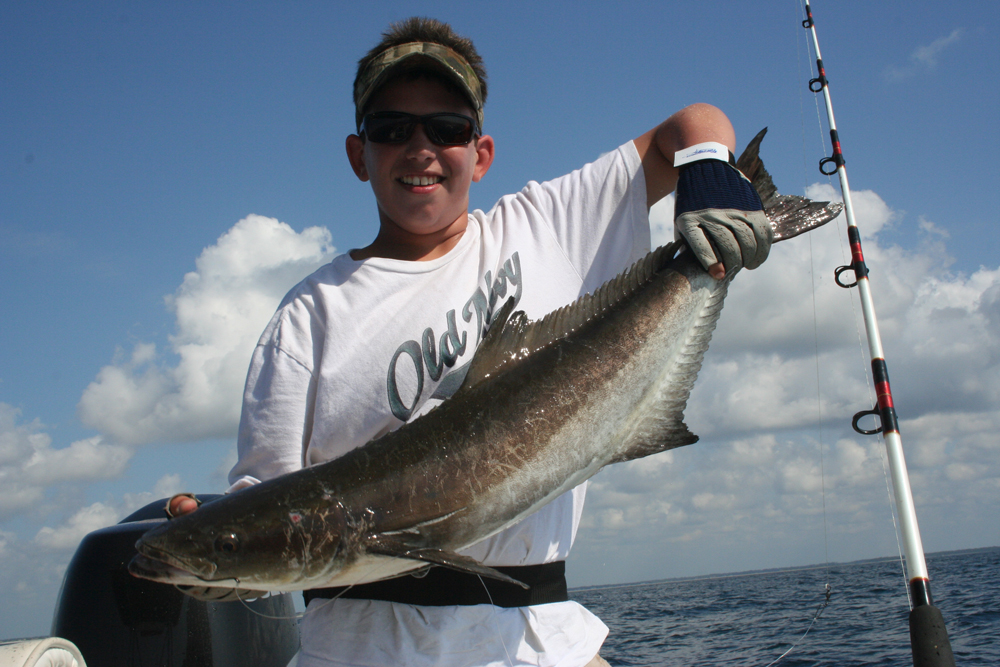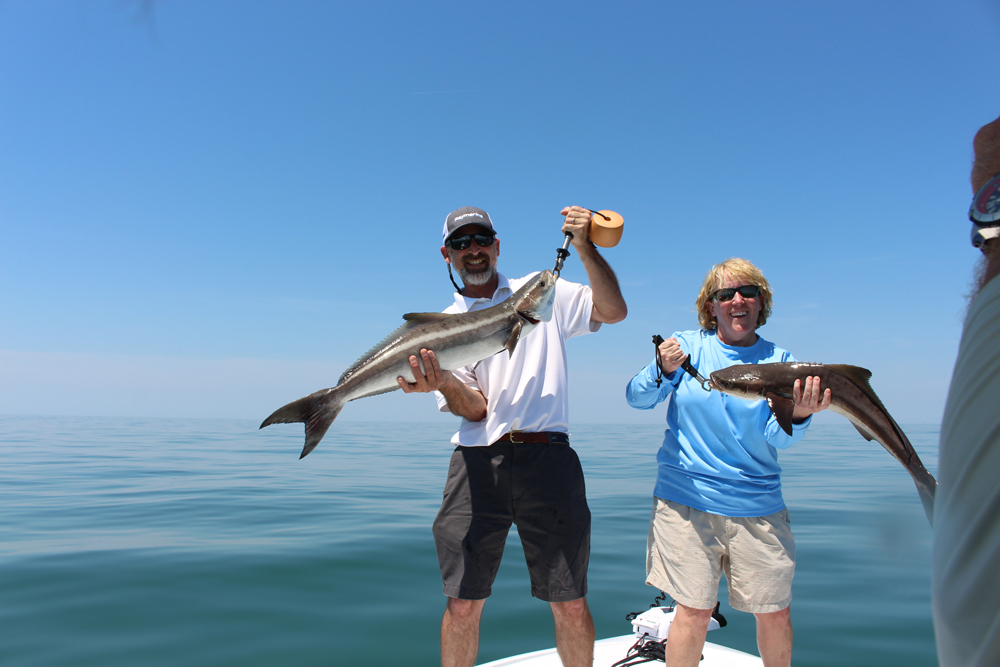For the past few years we've seen a terrific cobia bite in the lower and lower-middle Chesapeake Bay, as well as inshore along the DelMarVa coast. If you pay attention to our Way South Chesapeake & VA reports, you'll know when the cobia show up in Virginia’s waters. This species is commonly targeted in our region in one of three ways: sight casting to them, chumming, and trolling. Check out this short video with three general cobia fishing tips, before you move on to sight fishing and chumming tips.
Sight Casting for Cobia
- Cobia are actually bottom feeders, and those lazing about near the surface often aren’t in a feeding mood. You may have to tease them into striking—and the most effective way to do so is to toss out a live bait. Eels rate high on the list, as do live spot or mullet. Throw the bait well beyond the cobe and retrieve it until it’s about 10’ or 12’ in front of the fish, then freespool the reel and live-line it.
- Quite often you can cast plugs, bucktails, jigs, and spoons to cobia on the surface, and the fish will either swim lethargically towards the lure then turn away or ignore it entirely. One tactic that will sometimes get them to strike is to cast a jig five or 10 feet in front of the fish and allow your lure to free-fall. For some reason cobia seem to be attracted to lures heading straight down, and will often chase them. Both the lure and the fish will disappear from view as they go deep, but you’ll know the fish has hit when you feel a bump on the line. Two to three ounce bucktails dressed with twister tails, and large plastics such as BKDs, Bass Assassins, or Fin-S lures rigged on a one ounce leadhead, are often killers in this situation.
- If you spot cobia very close to your boat and they suddenly disappear, don’t give up hope—these fish tend not to be afraid of boats, and will often swim right underneath them for a bit of shade. When close-by cobia disappear, deploy baits or lures right next to the boat for several minutes. With startling frequency, the cobia will shoot out from underneath the boat and suddenly attack.

Chumming for Cobia
- Cobia love crustaceans, and a mesh bag filled with crushed blue crabs is an excellent chum-enhancer. Of course, purchasing dozen of crabs as chum would be expensive. Solve this problem by approaching the manager of your local seafood store, and ask if they’ll sell you their die-offs. So long as the die-offs haven’t been sitting in the sun all day they will work fine, and the seafood stores or roadside crab stands are usually happy to give you a full bushel basket for an extremely reduced price. Then bait your hooks with half a peeler or soft crab.
- Put a live bait or two into the mix, along with your cut baits. Eels and spot are excellent for this, and should either be allowed to swim near the surface free of weight or be suspended beneath a float or balloon.
- Serious cobia chummers will set chum both at the surface, and deep in a weighted chum pot. Similarly, baited lines should be set throughout the water column. But there’s one hitch, especially in the lower reaches of the Chesapeake and along the coast: deep lines will often be eaten by sharks and rays. You can’t really prevent this, just make sure you come prepared with plenty of extra hooks and leader.
See our video on how to chum those cobia up!
Bonus Cobia Tip: You’ll often spot cobia in pairs, and these pairs usually stick close by each other even when one of the fish gets hooked. You can commonly get a double hook-up by repeatedly tossing a bait or lure in front of the second, un-hooked fish, as the one on the line is brought close to the boat. Give this a shot at least five or six times before landing the hooked fish. Even though the bait or lure may be rejected several times, the cobia sometimes seem to get aggravated or aggressive after multiple presentations.

Double-Bonus Cobia Tip: These fish will sometimes allow themselves to be drawn right up to the boat rather quickly, and then go into a tug-of-war holding pattern just outside of landing range. When this happens, don’t be in any hurry to net the fish. Cobia take a long time to wear down, and landing them when they are green is a big mistake—they’ll go crazy in the boat, slamming gear and people all over the cockpit. Instead, slap the water’s surface, tap the fish’s tail with the tip of another rod, or otherwise aggravate it into running, to tire it.
Trolling for Cobia
- Pull planers to get the offering down, in size number two or number three. Then add a long (20 or so feet) 50-pound test leader, capped off with a large 24-inch surgical hose tube lure. Be sure to add ball-bearing swivels at both ends to reduce line twist, which can be very problematic with these lures.
- Before deploying the rig put the tube's hook through the eye, then twist it into a figure eight and give a hard tug. This will put a bend into the tube so it corkscrews as it moves through the water, giving it a swimming motion.
- Red and pink tubes are usually the best choices, but mix in at least one yellow or green tube. You just never know what the fish will want!
See Trolling Tubes for Cobia for more in-depth information on the tactic.
KILLER COBIA RECIPE
- Mix blue cheese salad dressing and mayonnaise in a 50-50 ratio. You’ll need about two cups to cover four half-pound fillets or steaks.
- Slather the fish in the mix, being sure to cover it 100-percent, as thickly as possible.
- Bake at 375-degrees for about 15 minutes, or until the coating turns brown.
Editor's note: This article was originally published in March of 2008 and was last updated in June of 2024.